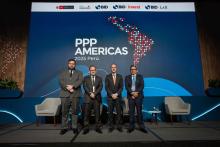
This was stated by the Head of the OECD team for Peru and Colombia, Paula Garda.
The economist member of the Organization for Economic Cooperation and Development (OECD), Paula Garda, makes an analysis of Peru's economic performance and what could come next year, in statements to the newspaper El Peruano .
It is expected that Peru's public debt as a percentage of GDP will remain one of the lowest in the region.
–There has been a substantial increase in private investment following the launch of important infrastructure projects such as the port of Chancay. What else could Peru do to speed up these investments?
–Private investment could perform better than expected. It is true that the Executive is working to unblock PPPs (public-private partnerships), but if there were greater progress, it could have a better impact on the economy.
Another thing that could also boost this is better than expected global growth, so that Peruvian exports would be better and, therefore, there would be better growth for Peru.
–Do you think, then, that private investment could increase in the coming months?
–In a baseline scenario, there are downside risks and upside risks. However, and ultimately, if the measures being implemented by the Government work, I think so.
To date, it is still difficult to measure the impact of large investments such as the port of Chancay or the new Jorge Chávez International Airport because they depend on other investments in infrastructure to connect different companies, regions, localities, which could result in greater economic growth.
These investments are not here now, but if they were, they could definitely boost GDP to more than 2.6% in 2026.
–The OECD's demands are clear: tax, fiscal and labour reforms must be carried out in order to join this bloc. What specific measures could these be?
–In fiscal terms, the main message is that we need to get back to complying with the rules. The economy will grow by 3%, but that will not yet be the target. However, there are better fiscal prospects for next year.
Here is part of what should be done: improving the governance of public companies. On the other hand, there are many pressures on current expenditure in the short term and, clearly, in the pre-election years these pressures tend to be greater.
This is normal in all economies, not just in Peru, but it will be necessary to contain this pre-election spending to comply with the fiscal rule.
I think an important message is that public investment is increasing, although in the past we have seen that public investment is not the most efficient.
Reforms are needed to improve the effectiveness of this investment and ensure that it achieves the expected results.
–In the medium or long term, where should efforts be focused to continue closing gaps?
–There is a great need for social and infrastructure investments, and therefore it will be necessary to increase public spending; therefore, higher tax revenues will be required, which are relatively low when compared to other OECD countries.
So, with what we have, we must first spend better. In terms of GDP, Peru spends something similar on public investment to what OECD countries spend.
On the tax reform side, tax exemptions should not be increased.
–Regarding informality, what message should Peru have clearly?
–Reducing informality in the economy is a priority. This has several dimensions. If private investment increases, it helps reduce informality by generating employment.
This is why fewer bureaucratic barriers are needed.
There is also a clear need to improve tax schemes for SMEs, as the current ones provide little incentive to remain “small”, low in terms of productivity and, above all, informal.
Finally, there is a clear need to improve access to education, the quality of education and job training.
–Congress is promoting measures contrary to what you mentioned on the tax issue. What is the OECD's position in this regard?
–The OECD's position is that this differentiated tax reduction tends to reduce the tax base.
They are considered tax expenditures. When I say that Peru has room to increase its tax revenues, I was referring to this type of thing, eliminating all these tax expenditures that do not meet their objective or that will not have any impact on companies.
These initiatives need to be carefully analysed. There are other instruments that can be used. Instead of reducing taxes for everyone, this should be done in a targeted manner, aimed at those who really need it, such as small businesses in certain sectors.
–Apart from what has been mentioned, does the OECD believe that Peru still has solid macroeconomic fundamentals?
–Peru’s macroeconomic framework remains a clear strength. Its fiscal rules, its independent central bank, and its inflation targets are clearly solid. It is time to work to maintain it.
Peru's public debt is one of the lowest in the entire region, and we hope it will continue to be so. Furthermore, in the fight against inflation, Peru is already within the target range, second only to Costa Rica in the region.
–In terms of monetary policy, what are your projections for 2025?
–We had expected that there would be no reduction in the reference interest rate at the last meeting of the year, but we have seen that monetary policy has been relaxed during 2024.
Inflation is already within the target range, with projections for little movement, but always close to the BCR's goal and objective.
The interest rate is therefore expected to be cut slightly in 2025. There is room to bring monetary policy to a neutral tone.
ADHESION PROCESS
The head of the OECD team for Peru and Colombia revealed to this newspaper that our country is “really very involved” in its process of joining the OECD.
"He is clearly very keen to see the process completed in a timely manner and is progressing well," he said.
The economist said that the procedure could take time, but that will depend on the recommendations made by the organization through its different committees.
“Peru is undergoing a review in 24 committees. It is on that path, every two months it has evaluations. At the end, each committee will give its recommendations to be implemented to continue with the process. Some of these will not require legislative changes and others will. Therefore, the speed with which this whole process is concluded will also depend on the possibility of implementing these reforms of all kinds. These are issues linked from climate change to informality,” he explained.
DATA
- Peru would grow by more than 2.6% in 2026 with greater investments that allow for closing infrastructure gaps.
- Public investment is increasing sharply according to the OECD, but greater efficiency in state spending is needed.
- Peru's process of joining the OECD involves the review of up to 24 committees of the international organization linked to different topics.










